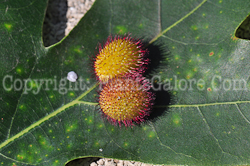 As
mentioned above there are dozens and dozens of
different galls that are commonly found on oak
trees. Here are just a few of them:
As
mentioned above there are dozens and dozens of
different galls that are commonly found on oak
trees. Here are just a few of them:
* Oak apple galls are light brown balls up to about
2 inches in diameter that form in oak leaves.
Inside contains a single larva of a type of wasp.
* Oak bullet galls
cause growths on twigs most commonly on bur oaks (Quercus
macrocarpa).
* Bullet galls are
small, hard round growths that appear in August.
* Jumping oak galls
are small, hard growths on leaves. Inside each gall
is the larva of the insect which, when they drop to
the ground, begin to jump around resembling Mexican
jumping beans.
* Oak pill galls form
irregular, hardened growth that are up to 1/4 inch
in diameter on the upper surface of the leaf.
* Woody oak galls
resemble a dense wad of wool which is attached to
the midvein of the leaf.
* Horned oak galls
form on the stems of several types of oaks.



